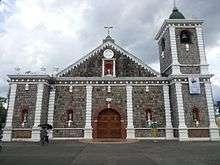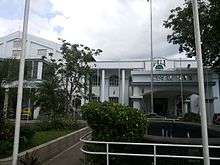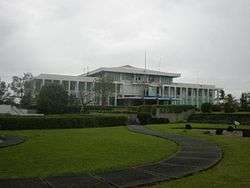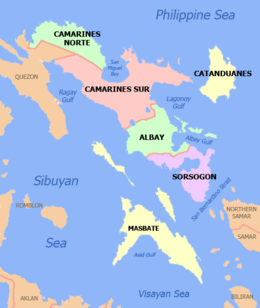Pili, Camarines Sur
| Pili | |
|---|---|
| Municipality | |
|
Capitol building of Camarines Sur | |
| Nickname(s): The Capital Town of Camarines Sur | |
| Motto: "Higos Pili" | |
 Location in the province of Camarines Sur | |
.svg.png) Pili Location within the Philippines | |
| Coordinates: 13°35′N 123°18′E / 13.58°N 123.3°ECoordinates: 13°35′N 123°18′E / 13.58°N 123.3°E | |
| Country | Philippines |
| Region | Bicol (Region V) |
| Province | Camarines Sur |
| District | 3rd district |
| Founded | 1789 |
| No. of Barangays | 26 |
| Government[1] | |
| • Mayor | Tom Bongalonta |
| Area[2] | |
| • Total | 126.25 km2 (48.75 sq mi) |
| Population (2015 census)[3] | |
| • Total | 89,545 |
| • Density | 710/km2 (1,800/sq mi) |
| Time zone | PST (UTC+8) |
| ZIP code | 4418 |
| IDD : area code | +63 (0)54 |
| Income class | 1st class |
| Urban/Rural | urban |
| Website |
www |
Pili (Central Bicolano: Banwaan kan Pili; Rinconada Bikol: Banwāan ka Pili; English: Municipality of Pili; Tagalog: Bayan ng Pili) is a first class municipality and the capital of the province of Camarines Sur in the Bicol Region of the Philippines. According to the 2015 census, it has a population of 89,545 people.[3]
The municipality was classified as 1st class in terms of income classification in 2007.[2] Pili is one of the municipalities comprising the metropolitan area of Metro Naga, serving as the center for agro-industrial development.
History
The name of the town has many disputed etymologies. The most popular is it might have been derived from the "Pili nut" (Canarium ovatum), the fruit which is among the symbols of the Bicol region. However, historians are convinced that it came from the Bicol word "pili", which means "to choose" or "the chosen" - probably the reason why the town was hailed as the provincial capital and not its neighboring Naga City.
The first recorded history of Pili started during the promulgation of Christianity in the early 1770s by the Spanish missionaries. The early center of settlement in the town is located in "Binanuaanan" (from "banwaan" which means town) until missionaries transferred it to the present site of the town proper where the St. Raphael Archangel Church is located.
It was believed that its development as a town started when the road from Pili leading to Lagonoy, which was also the route to Legazpi City and Naga City, was constructed. Furthermore, the establishment of the Philippine National Railways (PNR) station in the municipality paved the way for Pili to become the second largest center of commerce in the province, next to the city of Naga.
It was formally established in 1919 as a municipality. On June 6, 1955, Pili was declared the new provincial capital of Camarines Sur by virtue of Republic Act 1336, replacing Naga City.[4] The site of the Provincial Capitol is in the barangay of Cadlan.
Barangays
Pili is politically subdivided into 26 barangays.[2]
- Anayan
- Bagong Sirang
- Binanuaanan
- Binobong
- Cadlan
- Caroyroyan
- Curry
- Del Rosario
- Himaao
- La Purisima
- New San Roque
- Old San Roque (Poblacion)
- Palestina
- Pawili
- Sagrada
- Sagurong
- San Agustin
- San Antonio (Poblacion)
- San Isidro (Poblacion)
- San Jose
- San Juan (Poblacion)
- San Vicente (Poblacion)
- Santiago (Poblacion)
- Santo Niño
- Tagbong
- Tinangis
Demographics
| Population census of Pili | ||
|---|---|---|
| Year | Pop. | ±% p.a. |
| 1990 | 52,481 | — |
| 1995 | 61,520 | +3.02% |
| 2000 | 67,393 | +1.97% |
| 2007 | 76,496 | +1.76% |
| 2010 | 82,307 | +2.70% |
| 2015 | 89,545 | +1.62% |
| Source: Philippine Statistics Authority[3][5] | ||

In the 2015 census, the population of Pili, Camarines Sur, was 89,545 people,[3] with a density of 710 inhabitants per square kilometre or 1,800 inhabitants per square mile.
Languages
There are two Bicol languages used all over the municipality, Central Bicolano on the northern part, and Riŋkonāda or Rinconada Bikol on the south. However, Central Bicolano is the lingua franca, used all throughout the town for communication. Tagalog and English language are also widely understood.
Religion
Roman Catholicism is the predominant religion in the municipality, where the town is under the jurisdiction of the Archdiocese of Caceres in Naga City. It is followed by the Iglesia Ni Cristo.
Economy
Urbanization had a great effect on the town of Pili. Just a neighboring town of Naga City, a percentage of the population still relies on Naga City's industries for jobs, and universities for education. Pili is the traditional secondary growth center of the Metro Naga. The town is also hailed many times as one of the most competitive municipalities in the Bicol region and the whole country.[6] Now, Pili is reputed as the Bicol region's burgeoning industrial town with its giant warehouses and milling plants.[7]

It is commonly known as 'Centro', which means "center" among the locals. The area has been the center of commerce and businesses in the town. The "Daang Maharlika" or the national road is the main road of the town proper, where it stretches from San Isidro to Santiago. It is the location of the Pili Municipal Hall, St. Raphael the Archangel Church, and the Pili Public Market.
Pili is the third largest commercial center in Camarines Sur, and is the 10th largest commercial center in the Bicol Region. The town hosts the very first SM Savemore Market in the Bicol Region, and soon the fourth Puregold in the same region. It is also the first municipality in Metro Naga to have a Jollibee restaurant, better known as "Jollibee Pili Centro". Robinsons also has planned to expand their commerce in Bicol, by instituting a supermarket at the Diversion Road, near the crossing by Bula, which would be the third in Bicol. LCC also has instituted their own mall in Pili, which was the incorporation of the LCC Supermarket, the old Public Market, and LCC Department Store. Another mall in Pili is the MetroCenter Pili which is the mall developed by Westpark Development Corporation which aims to construct metropolitan malls in every municipality part of the Metropolitan Area of Naga City. The MetroCenter Pili is the first mall to be constructed after the main mall in Naga City, the Avenue Square, and leisure hub, Westpark Center.
Pili's major role in Metro Naga is the incubation of Agro-Industrial, and Industrial institutions. The Bicol Industrial Park located in Barangay San Jose is also a mass provider of jobs for Agro-Industrial purposes. The 120-hectare area houses the rice waste to energy plant sponsored by the Korean Government, the WL Manufacturing Center, the Bicol Rice Research and Graining Institute, Samsung Electronics Institute, and the Department of Agriculture Regional Office and Warehouse.
As of present, Pili is the regional manufacturer of Purefoods, and Lucky Star Food Products, and the state run Camarines Sur Manufacturing and Distribution Services. Pili is also the location of the massive, technologically advanced Bicol Granary and Food Manufacturing, which is the largest granary, and manufacturing institute in Southern Luzon. An ice plant owned by an Australian Company is set to open their own plant in the industrial park. The company is known to be SM's international company partner.
Pili also houses the imposing car sales and service centers of Toyota and Honda, both conceded to be among the biggest in South Luzon. Foton, a China-based automaker, also open their own service center in the town. Soon, a new plant will also be constructed in Pili for Subaru Motors, a near high-end car manufacturer.[7]
It is located at the eastern part of the town of Pili. The area is mainly characterized as the barangays near to the Mt. Isarog. Tourism in this part of the town is mainly due to Tinagrawan Falls (Tinangis), Curry Slide Falls, and Balang Falls. In this area is where Camp Elias Angeles, the 9th Infantry Division of the Philippine Army can also be found.
During the late 1980s, the town of Pili is known to be the "Bicol's sweetheart", because of its wide sugarcane plantation located at the foot of Mt. Isarog. The Penafrancia Sugar Mill (Pensumil) is a corporation that processes sugar canes is located at Barangay Himaao. This area is also the source of drinking water throughout the town of Pili via the Pili Water District and also for the whole Metro Naga.
The Camarines Sur Provincial Capitol is a 150-hectare land located at Barangay Cadlan. It is the center of governance and politics in the whole province. This area became famous because of tourism, mainly due to the Camarines Sur Watersports Complex, Lago del Rey, Camarines Sur Convention Center, and Camarines Sur Eco-park Village. It also houses the Camarines Sur Information Technology Park, which is a 5-hectare land with a call center building, animation center, English proficiency training center, and housing facilities.
Infrastructure
Transportation
Pili is the site of Naga Airport, which is the aerial gateway of the metropolitan area of Naga and the province of Camarines Sur. It is only approximately 10 kilometers south of Naga City.
The town is not coastal and thus depends mainly on land transportation. Major local transportation are either jeepneys or buses. Some barangays use motorcycles (habal-habal). The Philippine National Railways have a night train service from Manila called Mayon Limited. It arrives at Pili railway station at 5:58/5:59AM local time.
Utilities
Water supplied by newly established water system under the Pili Water District (PIWAD). Power and electricity is supplied by the Camarines Sur Electric Cooperative II (CASURECO II).
Education
Elementary schools
The inventory of schools in 1995 indicates the presence of 26 public elementary schools and 5 private schools. Each barangay has its own elementary schools. The DepEd Pili District Office is located inside the Pili Central School. The DepEd Camarines Sur Division Office is also located at the town, specifically at the Camarines Sur Freedom Stadium, in which the School of the Future can be found too. Private schools include Evangelical Christian School, Pili Parochial School, Blessed Name of Mary Learning School, and others.
Secondary schools
There are also three private and five government-owned secondary schools accounted. Public secondary schools include the Pili National High School in La Paz, and many others. The CBSUA (Main Campus) administered two high schools: the Computer Science High School of Bicolandia and its Laboratory High School. The Universidad de Sta. Isabel- Pili Campus, formerly-known as the St. Louise de Marillac School of Pili, is the campus of the said university in the town functioning only as a secondary institution. The Camarines Science Oriented High School also offers complete elementary and secondary courses.
Higher education
- Central Bicol State University of Agriculture (Main Campus)
- Philippine Computer Foundation College
- Pili Capital College, Inc.
- Camo College
- Kolehiyo ng Mamamayan (College of the People)
The proximity of the town to Naga City caused a lot of students from Pili to study also at the said city.
References
- ↑ "Municipalities". Quezon City, Philippines: Department of the Interior and Local Government. Retrieved 7 January 2013.
- 1 2 3 "Municipalities and Cities". PSGC Interactive. Retrieved on 2012-05-23.
- 1 2 3 4 "Region V (BICOL REGION)". Census of Population (2015): Total Population by Province, City, Municipality and Barangay (Report). PSA. Retrieved 20 June 2016.
- ↑ "Pili, Camarines Sur". Byahero.net. Retrieved 19 June 2014.
- ↑ "Province of Camarines Sur". Municipality Population Data. LWUA Research Division. Retrieved 24 July 2013.
- ↑ "Competitiveness of cities and municipalities in the Bicol Region". Bik-Lish. Retrieved 2015-09-07.
- 1 2 "Bicol's Boom Town: Bongat sees bullish Naga | Bicol Mail". www.bicolmail.com. Retrieved 2015-09-07.
External links
| Wikimedia Commons has media related to Pili, Camarines Sur. |
- Philippine Standard Geographic Code
- Philippine Census Information
- Official Site of the Province of Camarines Sur
 |
Naga City | Mount Isarog |  | |
| Milaor | |
Ocampo | ||
| ||||
| | ||||
| Minalabac | Bula |

